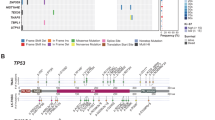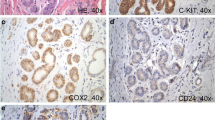Abstract
Pathological diagnosis of intraductal apocrine lesions can be challenging, because even benign apocrine lesions often show atypical cytology, and immunohistochemistry is of little assistance. A new diagnostic method for apocrine lesions is desirable. The mutations present in apocrine lesions have not been well studied. We performed a MassARRAY multiplex polymerase chain reaction (PCR) study of benign and malignant apocrine lesions, which included 152 mutations of 18 genes. We found that four of 11 benign lesions showed AKT1 or PIK3CA mutations, one of four noninvasive apocrine carcinomas showed a FBX4 mutation, two of 15 invasive apocrine carcinomas showed a PIK3CA mutation, and one invasive apocrine carcinoma showed both PIK3CA and TP53 mutations. The mutation frequency did not differ significantly between benign and malignant lesions (p = 0.683). We demonstrated that both benign and malignant apocrine lesions may contain mutations of genes in the PI3K–AKT pathway, this pathway could be a good therapeutic target of these diseases.



Similar content being viewed by others
References
Moritani S, Kushima R, Sugihara H, Bamba M, Kobayashi TK, Hattori T (2002) Availability of CD10 immunohistochemistry as a marker of breast myoepithelial cells on paraffin sections. Mod Pathol 15(4):397–405. https://doi.org/10.1038/modpathol.3880536
Werling RW, Hwang H, Yaziji H, Gown AM (2003) Immunohistochemical distinction of invasive from noninvasive breast lesions: a comparative study of p63 versus calponin and smooth muscle myosin heavy chain. Am J Surg Pathol 27(1):82–90
Moriya T, Kasajima A, Ishida K, Kariya Y, Akahira J, Endoh M, Watanabe M, Sasano H (2006) New trends of immunohistochemistry for making differential diagnosis of breast lesions. Med Mol Morphol 39(1):8–13. https://doi.org/10.1007/s00795-006-0309-8
Grin A, O'Malley FP, Mulligan AM (2009) Cytokeratin 5 and estrogen receptor immunohistochemistry as a useful adjunct in identifying atypical papillary lesions on breast needle core biopsy. Am J Surg Pathol 33(11):1615–1623. https://doi.org/10.1097/PAS.0b013e3181aec446
Moriya T, Kozuka Y, Kanomata N, Tse GM, Tan PH (2009) The role of immunohistochemistry in the differential diagnosis of breast lesions. Pathology 41(1):68–76. https://doi.org/10.1080/00313020802563544
Pathmanathan N, Albertini AF, Provan PJ, Milliken JS, Salisbury EL, Bilous AM, Byth K, Balleine RL (2010) Diagnostic evaluation of papillary lesions of the breast on core biopsy. Mod Pathol 23(7):1021–1028. https://doi.org/10.1038/modpathol.2010.81
Furuya C, Kawano H, Yamanouchi T, Oga A, Ueda J, Takahashi M (2012) Combined evaluation of CK5/6, ER, p63, and MUC3 for distinguishing breast intraductal papilloma from ductal carcinoma in situ. Pathol Int 62(6):381–390. https://doi.org/10.1111/j.1440-1827.2012.02811.x
Koo JS, Kim MJ, Kim EK, Park BW (2012) Comparison of immunohistochemical staining in breast papillary neoplasms of cytokeratin 5/6 and p63 in core needle biopsies and surgical excisions. Appl Immunohistochem Mol Morphol 20(2):108–115
Yang Y, Suzuki K, Abe E, Li C, Uno M, Akiyama F, Yamauchi H, Kikuchi M, Ohde S, Deshpande G, Shibahara Y, Nakamura Y, Sasano H (2015) The significance of combined CK5/6 and p63 immunohistochemistry in predicting the risks of subsequent carcinoma development in intraductal papilloma of the breast. Pathol Int 65(2):81–88. https://doi.org/10.1111/pin.12248
Tanaka S, Kanomata N, Teramura K, Wakita K, Kunihisa T, Yano Y, Moriya T, Hayashi Y (2016) Usefulness of immunocytochemistry using a Breast Marker antibody cocktail targeting P63/cytokeratin7/18/cytokeratin5/14 for fine needle aspiration of the breast: a retrospective cohort study of 139 cases. Cytopathology 27(6):465–471. https://doi.org/10.1111/cyt.12335
Maeda I, Tajima S, Kanemaki Y, Tsugawa K, Takagi M (2018) Use of immunohistochemical analysis of CK5/6, CK14, and CK34betaE12 in the differential diagnosis of solid papillary carcinoma in situ from intraductal papilloma with usual ductal hyperplasia of the breast. SAGE Open Med 6:2050312118811542. https://doi.org/10.1177/2050312118811542
Tramm T, Kim JY, Tavassoli FA (2011) Diminished number or complete loss of myoepithelial cells associated with metaplastic and neoplastic apocrine lesions of the breast. Am J Surg Pathol 35(2):202–211. https://doi.org/10.1097/PAS.0b013e31820598a2
Cserni G (2012) Benign apocrine papillary lesions of the breast lacking or virtually lacking myoepithelial cells-potential pitfalls in diagnosing malignancy. APMIS 120(3):249–252. https://doi.org/10.1111/j.1600-0463.2011.02840.x
Matsuo K, Fukutomi T, Hasegawa T, Akashi-Tanaka S, Nanasawa T, Tsuda H (2002) Histological and immunohistochemical analysis of apocrine breast carcinoma. Breast Cancer 9(1):43–49
Vranic S, Gatalica Z, Deng H, Frkovic-Grazio S, Lee LM, Gurjeva O, Wang ZY (2011) ER-alpha36, a novel isoform of ER-alpha66, is commonly over-expressed in apocrine and adenoid cystic carcinomas of the breast. J Clin Pathol 64(1):54–57. https://doi.org/10.1136/jcp.2010.082776
Moriya T, Sakamoto K, Sasano H, Kawanaka M, Sonoo H, Manabe T, Ito J (2000) Immunohistochemical analysis of Ki-67, p53, p21, and p27 in benign and malignant apocrine lesions of the breast: its correlation to histologic findings in 43 cases. Mod Pathol 13(1):13–18. https://doi.org/10.1038/modpathol.3880004
Nozaki F, Hirotani Y, Nakanishi Y, Yamaguchi H, Nishimaki H, Noda H, Tang X, Yamamoto H, Suzuki A, Seki T, Masuda S (2016) p62 regulates the proliferation of molecular apocrine breast cancer cells. Acta Histochem Cytochem 49(4):125–130. https://doi.org/10.1267/ahc.16013
Troxell ML, Levine J, Beadling C, Warrick A, Dunlap J, Presnell A, Patterson J, Shukla A, Olson NR, Heinrich MC, Corless CL (2010) High prevalence of PIK3CA/AKT pathway mutations in papillary neoplasms of the breast. Mod Pathol 23(1):27–37. https://doi.org/10.1038/modpathol.2009.142
Toker A, Cantley LC (1997) Signalling through the lipid products of phosphoinositide-3-OH kinase. Nature 387(6634):673–676. https://doi.org/10.1038/42648
Datta SR, Dudek H, Tao X, Masters S, Fu H, Gotoh Y, Greenberg ME (1997) Akt phosphorylation of BAD couples survival signals to the cell-intrinsic death machinery. Cell 91(2):231–241
Hers I, Vincent EE, Tavare JM (2011) Akt signalling in health and disease. Cell Signal 23(10):1515–1527. https://doi.org/10.1016/j.cellsig.2011.05.004
Carnero A, Blanco-Aparicio C, Renner O, Link W, Leal JF (2008) The PTEN/PI3K/AKT signalling pathway in cancer, therapeutic implications. Curr Cancer Drug Targets 8(3):187–198
Samuels Y, Diaz LA, Schmidt-Kittler O, Cummins JM, Delong L, Cheong I, Rago C, Huso DL, Lengauer C, Kinzler KW, Vogelstein B, Velculescu VE (2005) Mutant PIK3CA promotes cell growth and invasion of human cancer cells. Cancer Cell 7(6):561–573. https://doi.org/10.1016/j.ccr.2005.05.014
Beaver JA, Gustin JP, Yi KH, Rajpurohit A, Thomas M, Gilbert SF, Rosen DM, Ho Park B, Lauring J (2013) PIK3CA and AKT1 mutations have distinct effects on sensitivity to targeted pathway inhibitors in an isogenic luminal breast cancer model system. Clin Cancer Res 19(19):5413–5422. https://doi.org/10.1158/1078-0432.CCR-13-0884
O'Malley FP, Page DL, Nelson EH, Dupont WD (1994) Ductal carcinoma in situ of the breast with apocrine cytology: definition of a borderline category. Hum Pathol 25(2):164–168
D'Arcy C, Quinn C (2019) Apocrine lesions of the breast: part 1 of a two-part review: benign, atypical and in situ apocrine proliferations of the breast. J Clin Pathol 72(1):1–6. https://doi.org/10.1136/jclinpath-2018-205484
Nomoto Y, Yoshinaka H, Ohi Y, Hayashi N, Nagata A, Sueyoshi K, Eguchi Y, Shinden Y, Kijima Y, Natsugoe S (2018) Apocrine papillary lesion: comparison of pathological findings from 22 years previously and the present. Breast Cancer. https://doi.org/10.1007/s12282-018-00936-1
Volckmar AL, Leichsenring J, Flechtenmacher C, Pfarr N, Siebolts U, Kirchner M, Budczies J, Bockmayr M, Ridinger K, Lorenz K, Herpel E, Noske A, Weichert W, Klauschen F, Schirmacher P, Penzel R, Endris V, Stenzinger A (2017) Tubular, lactating, and ductal adenomas are devoid of MED12 Exon2 mutations, and ductal adenomas show recurrent mutations in GNAS and the PI3K-AKT pathway. Genes Chromosomes Cancer 56(1):11–17. https://doi.org/10.1002/gcc.22396
Lee TH, Perrem K, Harper JW, Lu KP, Zhou XZ (2006) The F-box protein FBX4 targets PIN2/TRF1 for ubiquitin-mediated degradation and regulates telomere maintenance. J Biol Chem 281(2):759–768. https://doi.org/10.1074/jbc.M509855200
Lin DI, Barbash O, Kumar KG, Weber JD, Harper JW, Klein-Szanto AJ, Rustgi A, Fuchs SY, Diehl JA (2006) Phosphorylation-dependent ubiquitination of cyclin D1 by the SCF(FBX4-alphaB crystallin) complex. Mol Cell 24(3):355–366. https://doi.org/10.1016/j.molcel.2006.09.007
Li Y, Hao B (2010) Structural basis of dimerization-dependent ubiquitination by the SCF(Fbx4) ubiquitin ligase. J Biol Chem 285(18):13896–13906. https://doi.org/10.1074/jbc.M110.111518
Barbash O, Zamfirova P, Lin DI, Chen X, Yang K, Nakagawa H, Lu F, Rustgi AK, Diehl JA (2008) Mutations in Fbx4 inhibit dimerization of the SCF(Fbx4) ligase and contribute to cyclin D1 overexpression in human cancer. Cancer Cell 14(1):68–78. https://doi.org/10.1016/j.ccr.2008.05.017
Korcheva VB, Levine J, Beadling C, Warrick A, Countryman G, Olson NR, Heinrich MC, Corless CL, Troxell ML (2011) Immunohistochemical and molecular markers in breast phyllodes tumors. Appl Immunohistochem Mol Morphol 19(2):119–125. https://doi.org/10.1097/PAI.0b013e3181f5349a
Carpten JD, Faber AL, Horn C, Donoho GP, Briggs SL, Robbins CM, Hostetter G, Boguslawski S, Moses TY, Savage S, Uhlik M, Lin A, Du J, Qian YW, Zeckner DJ, Tucker-Kellogg G, Touchman J, Patel K, Mousses S, Bittner M, Schevitz R, Lai MH, Blanchard KL, Thomas JE (2007) A transforming mutation in the pleckstrin homology domain of AKT1 in cancer. Nature 448(7152):439–444. https://doi.org/10.1038/nature05933
Acknowledgements
This study was supported by grants from Kawasaki Medical School (No. 25K17). The authors thank Hiroko Murakami for her excellent secretarial support and Megumi Kuriyama for her technical support.
Author information
Authors and Affiliations
Corresponding author
Ethics declarations
Conflict of interest
The authors declare that they have no conflicts of interest.
Additional information
Publisher’s Note
Springer Nature remains neutral with regard to jurisdictional claims in published maps and institutional affiliations.
Rights and permissions
About this article
Cite this article
Kanomata, N., Yamaguchi, R., Kurebayashi, J. et al. Multiplex PCR analysis of apocrine lesions shows frequent PI3K–AKT pathway mutations in both benign and malignant apocrine breast tumors. Med Mol Morphol 53, 15–20 (2020). https://doi.org/10.1007/s00795-019-00226-5
Received:
Accepted:
Published:
Issue Date:
DOI: https://doi.org/10.1007/s00795-019-00226-5




